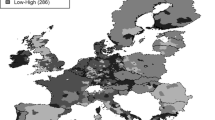Conclusion
The scenarios delineate a framework within which the financial consequences of eastern enlargement move against the background of more or less far-reaching reforms of internal EU policies. They clearly indicate that enlargement need not come to grief on the costs associated with it. The burden imposed on the budget can be kept within reasonable bounds given changes in internal EU policies that should be implemented in any case. If these policies are not modified, the analysis shows that structural policy is a more serious obstacle to accession than agricultural policy. If the capability of a national economy to absorb transfers efficiently is taken into account by introducing a fixed ceiling on EU support as a proportion of GDP, it would make a decisive contribution towards facilitating eastern enlargement. Irrespective of enlargement it is vital that further progress is made with agricultural policy reform. Agricultural policy remains the most important item of spending in the EU (15) budget. It is only here that the—inevitably substantial—resources required for eastern enlargement can be freed up.
Similar content being viewed by others
o
Poland, the Czech and Slovak Republics, Hungary, Slovenia, Bulgaria, Romania, Estonia, Latvia and Lithuania.
The full report is to be published in the spring of 1997 under the title Ostmitteleuropa auf dem Weg in die EU—Transformation, Verflechtung, Reformbedarf der EU. In: Beiträge zur Strukturforschung des DIW, Duncker & Humblot, Berlin.
The year 2005 would, however, appear more realistic than the year 2000, a date frequently mentioned. Cf. Poland's Path to the European Union, in: Economic Bulletin, vol. 32, no. 12, December 1995.
Poland, the Czech and Slovak Republics, Hungary and Slovenia. The results for an enlargement encompassing all ten of the associated countries of eastern central European can be found in the German report, the details of which are given in footnote 2.
According to the directive on the implementation of structural policy, the Commission takes account of the following criteria in dividing the resources among the regions entitled to support: “national wealth, regional wealth, regional population and the relative incidence of structural problems” (Article 12 (4) of Directive No. 2052/88 in the amended version of 20.7.1993). As it is the transfers to the newly admitted countries that are to be estimated here, we can abstract from the regional wealth of specific support regions.
Cf. Stefan Tangermann, Timothy E. Josling, Wolfgang Münch, Pre-accession Agricultural Policies for Central Europe and the European Commission. Study commissioned by DG I of the European Commission, Final Report 1994.
Cf. The EC budget plan for 1996, in: Official Journal of the EC L 22/1996.
Rights and permissions
About this article
Cite this article
Weise, C. Reforms necessary if eastern enlargement of the EU is to be financed. Economic Bulletin 34, 29–36 (1997). https://doi.org/10.1007/s10160-997-0034-9
Issue Date:
DOI: https://doi.org/10.1007/s10160-997-0034-9




